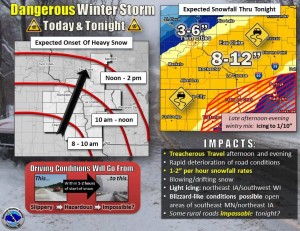 Snow moving in this morning. Once the heavy snow starts, roads will quickly go from slippery to treacherous – in as little 1 to 2 hours. Snowfall rates of 1-2″ still expected, with totals of 8 to 12 inches in the main snow band. Several inches less for parts of northeast IA and southwest WI where warmer air will make a wintry mix more likely for the afternoon-early evening hours. Don’t travel later today if don’t absolutely have to. Road closures in some rural parts of IA likely tonight. Stay safe…even the groundhogs are.
Snow moving in this morning. Once the heavy snow starts, roads will quickly go from slippery to treacherous – in as little 1 to 2 hours. Snowfall rates of 1-2″ still expected, with totals of 8 to 12 inches in the main snow band. Several inches less for parts of northeast IA and southwest WI where warmer air will make a wintry mix more likely for the afternoon-early evening hours. Don’t travel later today if don’t absolutely have to. Road closures in some rural parts of IA likely tonight. Stay safe…even the groundhogs are.
Richland County to Host Storm Spotter Training
In partnership with Richland County Emergency Management, the National Weather Service will be offering a storm spotter training class at the Richland Center Community Center (1050 N Orange Street) on March 14 from 6:30-8:30pm. This free training opportunity will feature training on recognizing severe weather and how to report it. This interactive multimedia presentation is given by a meteorologist, including various images and video loops from past storms in Minnesota, Iowa, and Wisconsin.
Richland County typically calls upon Pine Valley Repeaters ARES/RACES members to be dispatched to specified locations due to their abilities to communicate real-time information via radio. However, you are still encouraged to attend even if you are not a trained radio operator. Contact information will be provided so any trained spotter may call in and report severe weather from their location. As a trained spotter, you would be able to watch the weather in the comfort of your home, knowing you have the knowledge on how to recognize a significant weather event, to quickly and accurately report it, to keep your family and neighbors safe.
This short training is recommended for anyone who regularly spends time outside, who are responsible for the safety of a group of people, or who enjoy learning about the weather. Because of the complexity of severe thunderstorms and the potential dangers involved, spotting is recommended for adults (18 yrs or older). High school and Middle school students are welcome to attend the class with a parent or other adult. The La Crosse NWS recommends spotters attend a training session at least every other year. For more information, please visit http://www.weather.gov/arx/skywarn_schedule or call 647-8187.
Cold Weather Car Hacks
Fixing Foggy Windshields
Cold months often mean constantly being plagued with fogged up windshields and windows, a dangerous condition if you’re on the road. To quickly clear fog without leaving a smudgy mess behind, keep a chalkboard eraser in your car.
Alternatively, rolling down the window and letting some fresh air in will quickly defog windows.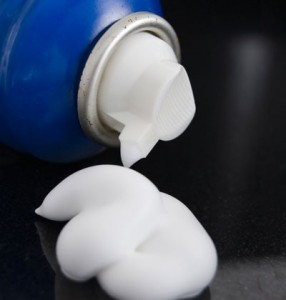
- Before you drive, put shaving cream on the inside of your windows and then wipe it off. Shaving cream has a lot of the same ingredients that commercial defoggers have, and it leaves a layer on the window to keep the fog off.
- Fill a stocking with kitty litter which absorbs water and keep that in your car overnight.
- Before you turn your car off each night, open the windows and let cold air in. The moisture from you breathing in your car will be replaced with dryer air.
- Don’t leave water bottles or other drinks in your car because the water becomes frost on the inside windows of your car.
- Also, the AC is one of the best defoggers around. The compressor takes the humidity out of the air.
During winte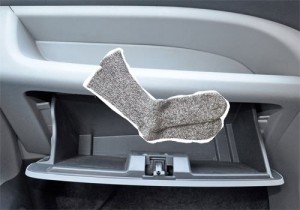 r, keep a spare pair of socks in your car’s glove-box to put on OVER your shoes. This trick gives you better traction in case you have to push your car over ice, or you just need to walk in snow and ice for some reason.
r, keep a spare pair of socks in your car’s glove-box to put on OVER your shoes. This trick gives you better traction in case you have to push your car over ice, or you just need to walk in snow and ice for some reason.
Spare socks are cheap, compact, and always useful. Plus they’re convenient as a makeshift cloth in a pinch. Thos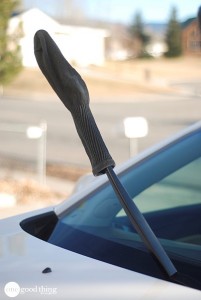 e extra socks can also come in handy for your wiper blades. Use an extra pair to cover your windshield wipers at night to keep the snow off of them. Raise the wipers off of the windshield and cover them up for easier de-icing in the morning.
e extra socks can also come in handy for your wiper blades. Use an extra pair to cover your windshield wipers at night to keep the snow off of them. Raise the wipers off of the windshield and cover them up for easier de-icing in the morning.
Soak a soft cloth with full-strength rubbing alcohol and wipe each blade. The alcohol will keep the blades from sticking to the window so they’ll function properly even on the coldest day of the year.
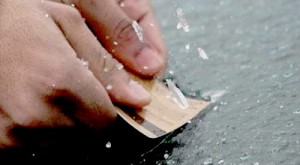 If you find yourself with frozen car windows but no ice scraper, you have a couple options – grab a spatula if you’re at a home, or use any plastic card in your wallet to get under the ice and scrape it away. Hopefully you’ll never forget your ice scraper again! 🙂
If you find yourself with frozen car windows but no ice scraper, you have a couple options – grab a spatula if you’re at a home, or use any plastic card in your wallet to get under the ice and scrape it away. Hopefully you’ll never forget your ice scraper again! 🙂
Whenever you can, make sure to park your car facing east. Since the sun rises in the east, it will naturally defrost your windshield in the morning so you won’t be stuck scraping ice in the freezing cold. With this trick you should be able to use your windshield wipers to do the not-so-heavy-lifting for you.
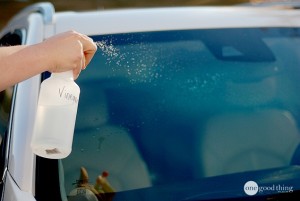 If parking facing east isn’t possible (or the sun isn’t cooperating)…mix three parts vinegar with one part water and spray the mixture onto your windshield to prevent ice from forming.
If parking facing east isn’t possible (or the sun isn’t cooperating)…mix three parts vinegar with one part water and spray the mixture onto your windshield to prevent ice from forming.
Keep plenty of windshield washer on hand
Here is an easy do-it-yourself recipe using basic household ingredients – Homemade Windshield Washer Fluid.
De-ice frozen car doors, locks, and handles
There are several clever ways to do this:
- Heat your car key with a match or lighter, then gently push the heated key into the lock to melt the ice as you apply pressure. Just be careful as that key will be hot!
- Another option is to take a regular drinking straw and blow directly onto the frozen lock. The heat from your breath should quickly melt the ice.
- Rubbing your key or door handle with a squirt of hand sanitizer will have the same effect. The alcohol in the hand sanitizer will melt the ice and shortly allow you to unlock your car.
Keep doors from freezing
- Sometimes putting WD-40 in the keyhole before the winter will keep any ice from forming in there in the first place.
- Cooking spray in the cracks of your doors and on the rubber will prevent them from freezing shut at night. Water that melts during the day runs in between your doors and freezes, but cooking spray keeps the water from resting in the cracks in the first place.
Frosty side mirrors
To prevent ice from forming on side mirrors, cover them the night before with plastic bags secured with rubber bands or clothespins. When you remove the bags in the morning, the mirrors will be ice-free.
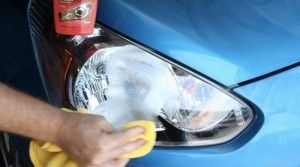 Increase headlight visibility
Increase headlight visibility
With the harsh weather and road conditions, headlights are especially important during the winter. Cover each light with toothpaste and rinse off with warm water. This will drastically improve the clarity of your lights and is much cheaper than the kits they sell at the store that provide the same service.
For added clarity, apply a layer of wax after you’ve removed the toothpaste. It will keep snow and water from sticking to them for weeks!
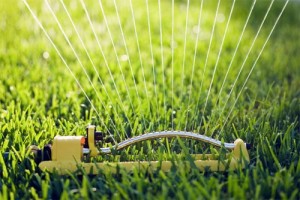 Keep your car’s “underthings” clean!
Keep your car’s “underthings” clean!
Make sure to clean your car often during the winter, as de-icing products can damage a car after prolonged exposure. To clean all the dirt, salt, and ice off the more difficult to reach under-carriage, run a lawn sprinkler underneath the car on a slightly warmer day. Just slide it under your car and drive back and forth over it. It will work wonders.
Easy ways to get un-stuck
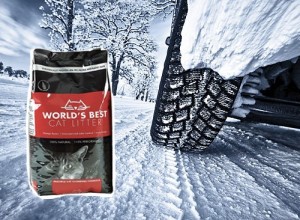 Keep a twenty pound bag of kitty litter in your trunk on snowy days. It’ll put some weight on your back tires — which is great for traction if you have rear-wheel drive — and if you do get stuck you’ll have something to provide a little traction. Just spread some under the tires and under your feet. A small shovel is helpful as well.
Keep a twenty pound bag of kitty litter in your trunk on snowy days. It’ll put some weight on your back tires — which is great for traction if you have rear-wheel drive — and if you do get stuck you’ll have something to provide a little traction. Just spread some under the tires and under your feet. A small shovel is helpful as well.
Another great trick for getting your car out of a snowbank? Your floor mats.. Place your front floor mats under your tires to give you some traction when on an icy surface. Just don’t forget to pick them back up after you get moving!
And finally……
A quick & easy emergency kit
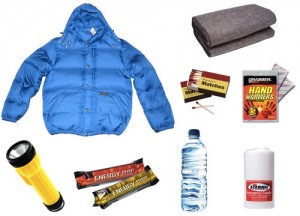 Hopefully you’ll never have to use it, but if you do, it could literally be a lifesaver!
Hopefully you’ll never have to use it, but if you do, it could literally be a lifesaver!
Unzip a winter coat. Inside, place extra socks and underwear, knit hat, gloves, scarf and snow pants. Zip the coat back up. You now have a compact emergency cold outfit.
Also toss in a candle and some matches, a warm blanket, hand/foot warmers, flashlight, bottle of water and energy bars.
Now we should all be ready to face whatever driving challenges winter has in store for us this year!
Taken from: http://www.onegoodthingbyjillee.com/2014/12/25-clever-car-hacks-help-survive-winter.html
Cold Weather and Cars
Make sure your vehicle is off to a great start this New Year by checking the following items:
- Antifreeze levels – ensure they are sufficient to avoid freezing.
- Battery and ignition system – should be in top condition and battery terminals should be clean.
- Brakes – check for wear and fluid levels.
- Exhaust system – check for leaks and crimped pipes and repair or replace as necessary. Carbon monoxide is deadly and usually gives no warning.
- Fuel and air filters – replace and keep water out of the system by using additives and maintaining a full tank of gas. A full tank will keep the fuel line from freezing.
- Heater and defroster – ensure they work properly.
- Lights and flashing hazard lights – check for serviceability.
- Oil – check for level and weight. Heavier oils congeal more at low temperatures and do not lubricate as well.
- Thermostat – ensure it works properly.
- Windshield wiper equipment – repair any problems and maintain proper washer fluid level.
- Install good winter tires – Make sure the tires have adequate tread. All-weather radials are usually adequate for most winter conditions. However, some jurisdictions require that to drive on their roads, vehicles must be equipped with chains or snow tires with studs.
Be sure to update the emergency kits in your vehicles with:
- A shovel
- Windshield scraper and small broom
- Flashlight
- Battery powered radio
- Extra batteries
- Water
- Snack food
- Matches
- Extra hats, socks and mittens
- First aid kit with pocket knife
- Necessary medications
- Blanket(s)
- Tow chain or rope
- Road salt and sand
- Booster cables
- Emergency flares
- Fluorescent distress flag
If a blizzard traps you in the car:
- Pull off the highway. Turn on hazard lights and hang a distress flag from the radio antenna or window.
- Remain in your vehicle where rescuers are most likely to find you. Do not set out on foot unless you can see a building close by where you know you can take shelter. Be careful; distances are distorted by blowing snow. A building may seem close, but be too far to walk to in deep snow.
- Run the engine and heater about 10 minutes each hour to keep warm. When the engine is running, open a downwind window slightly for ventilation and periodically clear snow from the exhaust pipe. This will protect you from possible carbon monoxide poisoning.
- Exercise to maintain body heat, but avoid overexertion. In extreme cold, use road maps, seat covers, and floor mats for insulation. Huddle with passengers and use your coat for a blanket.
- Take turns sleeping. One person should be awake at all times to look for rescue crews.
- Eat regularly and drink ample fluids to avoid dehydration, but avoid caffeine and alcohol.
- Be careful not to waste battery power. Balance electrical energy needs – the use of lights, heat, and radio – with supply.
- Turn on the inside light at night so work crews or rescuers can see you.
- If stranded in a remote area, stomp large block letters in an open area spelling out HELP or SOS and line with rocks or tree limbs to attract the attention of rescue personnel who may be surveying the area by airplane.
- Leave the car and proceed on foot – if necessary – once the blizzard passes.
For more information on how to be prepared for winter weather emergencies, visit http://www.ready.gov/winter-weather.
Cold Weather and Pets
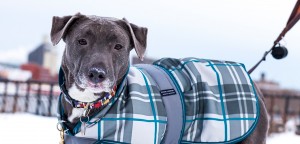 Exposure to winter’s dry, cold air and chilly rain, sleet and snow can cause chapped paws and itchy, flaking skin, but these aren’t the only discomforts pets can suffer. Winter walks can become downright dangerous if chemicals from ice-melting agents are licked off of bare paws. To help prevent cold weather dangers from affecting your pet’s health, please heed the following advice from the pet experts:
Exposure to winter’s dry, cold air and chilly rain, sleet and snow can cause chapped paws and itchy, flaking skin, but these aren’t the only discomforts pets can suffer. Winter walks can become downright dangerous if chemicals from ice-melting agents are licked off of bare paws. To help prevent cold weather dangers from affecting your pet’s health, please heed the following advice from the pet experts:
- Repeatedly coming out of the cold into the dry heat of your home can cause itchy, flaking skin. Keep your home humidified and towel dry your pet as soon as he comes inside, paying special attention to his feet and in-between the toes. Remove any snow balls from between his foot pads.
- Never shave your dog down to the skin in winter, as a longer coat will provide more warmth. If your dog is long-haired, simply trim him to minimize the clinging ice balls, salt crystals and de-icing chemicals that can dry his skin, and don’t neglect the hair between his toes. If your dog is short-haired, consider getting him a coat or sweater with a high collar or turtleneck with coverage from the base of the tail to the belly. For many dogs, this is regulation winter wear.
- Bathe your pets as little as possible during cold spells. Washing too often can remove essential oils and increase the chance of developing dry, flaky skin. If your 4-legged family member must be bathed, ask your vet to recommend a moisturizing shampoo and/or rinse.
- Massaging petroleum jelly into paw pads before going outside can help protect from salt and chemical agents. Booties provide even more coverage and can also prevent sand and salt from getting lodged between bare toes and causing irritation. Use pet-friendly ice melts whenever possible.
- Like coolant, antifreeze is a lethal poison for dogs and cats. Be sure to thoroughly clean up any spills from your vehicle, and consider using products that contain propylene glycol rather than ethylene glycol.
- Pets burn extra energy by trying to stay warm in wintertime. Feeding your pet a little bit more during the cold weather months can provide much-needed calories, and making sure she has plenty of water to drink will help keep her well-hydrated and her skin less dry.
- Remember, if it’s too cold for you, it’s probably too cold for your pet, so keep your animals inside. If left outdoors, pets can freeze, become disoriented, lost, stolen, injured or killed. In addition, don’t leave pets alone in a car during cold weather, as cars can act as refrigerators that hold in the cold and cause animals to freeze to death.
Article From https://www.aspca.org/pet-care/general-pet-care/cold-weather-safety-tips